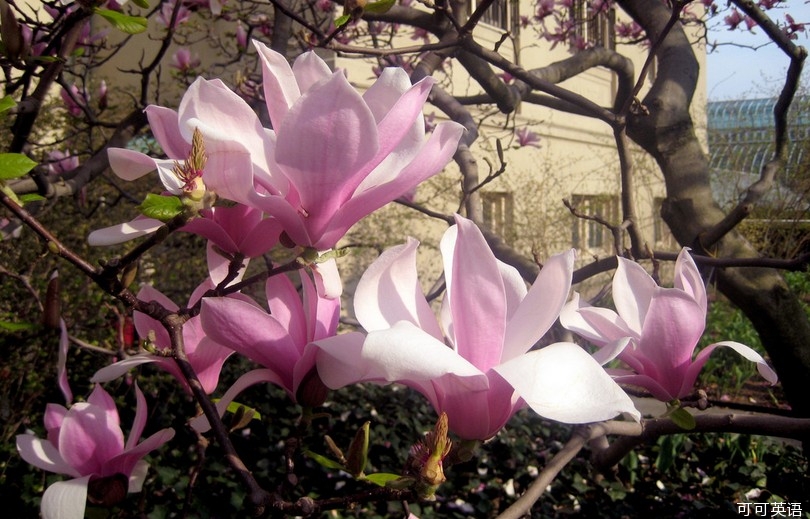(单词翻译:单击)

Boston is full of mourning and magnolia. Boylston Street, where limbs and lives were shredded on Monday, is still a crime scene. But parallel to it is Commonwealth Avenue, one of the world’s most handsome boulevards, lined with dark-red sandstone houses, where a great river of blossom now flows – flesh-pink cups, for the most part, but here and there a sprinkling of feathery white.
波士顿沉浸在哀悼和木兰花海当中。上周一血肉横飞的博伊尔斯顿街(Boylston Street),目前仍作为罪案现场被警方封锁。而与它平行的联邦大道(Commonwealth Avenue),是全世界最漂亮的街道之一,大道两旁坐落着一座座暗红色的砂岩外墙房屋——现在,这里已是一片木兰花海,大部分是肉粉色的花朵,另有些许如羽毛般的白色花朵点缀其中。
Bostonians, of which I was one for many years, come to gawk at the sudden shamelessness of the flowering, so at odds with the city’s customary inwardness and severity. Spring here is meant to be a gift as lavish as the winter is brutal. Until now, the usual threat to this outburst of April happiness has been the odd freak storm landing globs of clotted snow on the daffodils, breaking the necks of their stalks and the hearts of us gardeners.
突然怒放的木兰花让波士顿人看呆了。我曾在波士顿生活多年。这座城市一向内敛严肃,这波突如其来的花潮与其气质格格不入。春天对波士顿而言本是个奢侈的礼物——冬天有多严酷,春天就有多奢侈。直到不久前,有可能扑灭四月这场洋洋春意的还只是一种常见的威胁:反季节的暴风雪会在水仙花上留下凝结的雪团,压断它们的茎秆,让它们的主人心碎。
But the spring reawakening is also an act of history. Patriots’ Day, celebrated only in Massachusetts, and the day the murderers chose for their atrocious gratification, commemorates the beginning of American liberty, when on April 19 1775 on Lexington Green British redcoats in search of secret arms caches ran into a citizens’ militia determined to stop them. In a chaotic exchange of fire, eight of the Lexington Minutemen were killed. There was blood shed on that morning, too, but unlike whatever demented motives might have led to the Boylston bombings, Lexington’s blood was spilled in reluctant desperation and as an act of resistance to coercion.
春天的复苏也蕴含着历史。爱国者日(Patriots' Day)这个只有马萨诸塞州庆祝的节日,也即此次爆炸案凶手为满足自己残暴快感而选定的日子,本是为了纪念美国独立战争打响第一枪。1775年4月19日在列克星敦草地(Lexington Green),正在搜寻秘密军火库的英军士兵与一支决意要阻止他们的民兵队伍狭路相逢。八名列克星敦急召民兵(Minutemen)在混乱的交火中身亡。虽然那个早晨也有人流血,但与此次不知何种疯狂动机引发博伊尔斯顿街爆炸案不同,急召民兵血洒列克星敦是出于被迫的铤而走险、是以实际行动反抗压迫。
For years we lived in Lexington, and my wife and I would take the children to see the re-enactment of the battle before dawn, brimming with mixed loyalties but exhilarated by the drama that made history echo with the crack of muskets. It was high-class reconstruction, impeccable to the last detail of uniform, with British regulars looming out of the darkness to a steady drum beat, their major barking out the command to the “damned rebels” to lay down their arms; the volley and the return snap of musket fire; a general flight of the surviving Minutemen. Then, as light came up, we all trooped off for the fried dough that owed more to Boston’s Italian history than to 1775.
我们全家在列克星敦生活了多年,我和妻子曾带着孩子在黎明前出发,去看列克星敦战役的复原演出。我们的心中充满了矛盾的忠诚感,但随着滑膛枪声响起、演出把历史上的那一天重现在我们眼前,我们也感到了一种莫名的兴奋。复原演出的水准很高,连制服的细节都毫无瑕疵。英国正规军踏着固定的鼓点从黑暗中慢慢现出身影;英军少校大声喝令“该死的叛乱者”放下武器;随后传来排枪齐射和滑膛枪回击、子弹呼啸而过的声音;幸存的急召民兵大举溃逃。然后天就亮了,我们成群结队地奔向炸面团——这种食品更多地与波士顿意大利裔移民的历史有关,与1775年没有多大关系。
People thronged to Lexington from professorial Cambridge; from patrician Back Bay; from sylvan Lincoln and Wellesley, and from the gritty, “triple-decker” apartment blocks of Everett and Medford. Brit or Patriot, ferociously Irish (Noraid collection boxes could still be seen in the early 1980s in newsagents in Charlestown) or gently Armenian, we were all there, linked in a communion of memory; explaining to our kids what had been at stake all those centuries before; why it still mattered, why it was about something that changed the world.
云集在列克星敦的人们来自四面八方,比如学术气息浓厚的剑桥、富人区后湾(Back Bay)、林中小镇林肯(Lincoln)和韦尔斯利(Wellesley)、以及埃弗雷特(Everett)和梅德福(Medford)粗犷的“三层楼”(triple-decker)公寓街区。英国人也好爱国者也罢,脾气暴躁的爱尔兰人也好(上世纪80年代初,在查尔斯镇(Charlestown)的报刊亭仍可见到爱尔兰北方援助委员会(Noraid)的筹款箱)温文尔雅的亚美尼亚人也罢,我们都来到了这里,被一份共同的记忆联系在一起。我们要向孩子们解释数百年前到底什么事情曾处在紧急关头、那段历史在如今为何依然重要、为何说那段历史关乎的某种东西改变了世界。
The mutilations of Patriots’ Day 2013 were enacted in mindless cruelty, not mindful remembrance, and will change nothing; not even, one hopes, the public’s state of mind at all the sporting events that constitute the city’s true calendar of devotion, with Fenway Park, where the Red Sox baseball team play, its cathedral of light.
2013年爱国者日发生的惨案,是一种无意的暴行、而非有意的纪念,它不会改变任何东西;人们希望,它甚至不会改变波士顿人对该市众多体育赛事的心情。这些赛事才是波士顿人真正关心的,红袜队(Red Sox)的主场芬威球场(Fenway Park)不啻于该市的光明大教堂。
Above all, the futile atrocity will not damage Boston’s sense of itself as a city that refuses to be flattened into a generic version of urbanism, with the same malls, multiplexes and multistorey car parks controlling the rhythms of city life.
最重要的是,这种徒劳的暴行不会摧毁波士顿的自我认知——这座城市决不会自甘堕落、向千篇一律的城市生活方式举起白旗,让毫无特色的商场、多厅电影院和多层停车场控制城市生活的律动。
To be sure, all those things exist in Boston but so does the sense of a chain of urban villages; each distinct in their own way, some of them beautifully connected by Frederick Law Olmsted’s “emerald necklace” of parks and public gardens. South Boston is still hardcore Irish, facing the water; South End’s bow fronts forever in states of gentrification; cobblestoned Beacon Hill, built by land speculators in the earliest years of the Republic, where we lived for a while right below the golden domed State House, one of the most perfect expressions of residential neighbourhood ever designed.
当然,波士顿并不是没有这些设施,但除此之外,它还有一种都市化村庄集合体的韵味:每个区都有自己的特色,其中一些区被弗雷德里克•劳•奥姆斯特德(Frederick Law Olmsted)设计的公园和公共花园——也就是所谓的“翡翠项链”——巧妙地串接在一起。临海的南波士顿(South Boston)仍是传统的爱尔兰区;波士顿南区(South End)的弓形前沿永远处在升级改造、吸引中产阶级入住的状态;鹅卵石铺路的灯塔山(Beacon Hill)是美国建国初期地产投机商开发的,其设计堪称居住区的典范。我们全家曾在灯塔山住过一段时间,住所就在金顶的州议会大厦(State House)正下方。
And overlooking the bloodstained sidewalk is a place representing everything the murderers hate: civility, tolerance, enlightenment: Boston Public Library. Originally created in 1848 as America’s first free municipal library, it was rebuilt on its present site by the great Charles McKim in the 1890s. Go up the grand staircase and you will find the unfinished grandiloquent murals of John Singer Sargent, which he called “The Triumph of Religion”.
在此次爆炸案中,人行道被鲜血染红,而俯瞰这条人行道的就是波士顿公共图书馆(Boston Public Library)——这个地方代表着凶手所痛恨的一切:文明、宽容和启蒙。波士顿公共图书馆原馆建于1848年,是美国第一座免费市立图书馆,1890年由伟大的建筑师查尔斯•麦金(Charles McKim)主持、在现址重建。沿着该图书馆气派的楼梯往上走,你会看到约翰•辛格•沙金(John Singer Sargent)那组未完成的壁画,他为这组气势恢宏的壁画取名为“宗教的胜利”(The Triumph of Religion)。
But Sargent’s title is misleading for he meant his painting to be not a statement of dogma but its opposite – the triumph, in fact, of toleration; of the absolute privacy of moral convictions, a credo that linked the Virginian, Thomas Jefferson, with the Massachusetts sage, John Adams.
但沙金为这组画取的名字其实具有误导性,因为他这组画的本意不在于申明教义,恰恰相反,他其实是为了彰显“宽容的胜利”,以及道德信念的绝对隐私性——正是基于这种信条,弗吉尼亚人托马斯•杰斐逊(Thomas Jefferson)才与马萨诸塞哲人约翰•亚当斯(John Adams)联手。
Visibly moved at an interfaith ceremony in the city yesterday, President Barack Obama said the guilty would face justice. But perhaps whatever sentence is imposed on those who caused such suffering ought to include an obligation to march them up the library staircase and confront them with that imperishable American and universal truth: that a person’s beliefs are nobody’s business but their own. Heck, I’ll volunteer to do it myself.
波士顿上周四举行了有不同信仰的人参与的追思活动,出席此次活动的美国总统巴拉克•奥巴马(Barack Obama)激动地表示,一定会将罪犯绳之以法。但是,无论这场灾难的制造者会被处以何种刑罚,其中恐怕都应包含如下这项,那就是要押着他们走上波士顿公共图书馆的楼梯、去面对那个不仅适用于美国、也适用于全世界的永恒真理:一个人的信仰与他人无关,只关乎他自己。嘿,我愿主动请缨去做押解工作。


